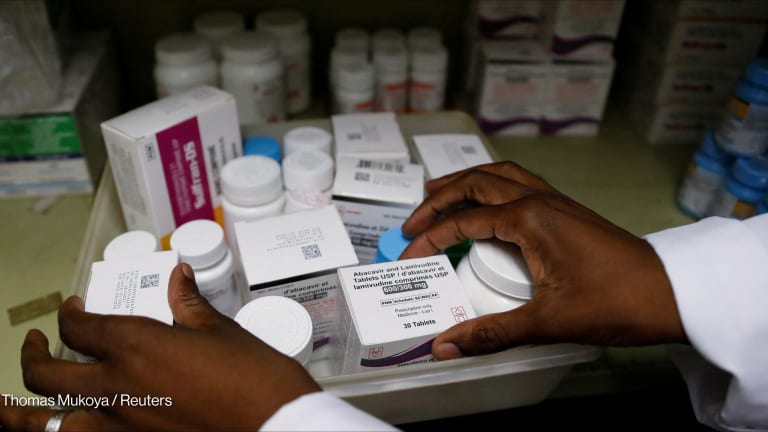
We have come a long way since the initiation of the U.S. President’s Emergency Plan for AIDS Relief in 2003, when millions around the world had no, or very limited, access to life-saving antiretroviral drugs. A decade and a half later, we are close to having the HIV epidemic under control in several key countries, but in doing so, the development community is facing a two-fold challenge. How we as practitioners approach this challenge will be critical to our success in controlling this deadly disease.
One year from now, PEPFAR will require other U.S. government agencies that receive PEPFAR funding for their programs — including the U.S. Agency for International Development — to allocate 70% of its $6.78 billion annual budget directly to local partners to provide HIV services.
Those same local partners will face increasing responsibility for leading their nation’s efforts to achieve ambitious targets around epidemic control: 90% of people living with HIV know their status; 90% of people who know their status are on treatment; and 90% of people on treatment have achieved viral suppression, all by 2020. For select countries, PEPFAR has established even more ambitious targets of 95-95-95 by 2020, based on their progress to date.
“With the right tools and support mechanisms, countries can achieve tremendous impact in their fight to end HIV.”
—This is happening at the same time that USAID is advancing countries’ “journey to self-reliance” “to achieve greater development outcomes and work toward a time when foreign assistance is no longer necessary.”
The success of this funding transition — while ensuring countries reach and sustain epidemic control targets — rests on the ability of local governments and organizations to have the data, capacity, and tools needed to effectively manage and monitor HIV programming.
The transition challenge
Local ownership is essential to sustain HIV epidemic control. Per PEPFAR’s country operational plan guidance for 2019, the purpose of this transition “is to increase the delivery of direct HIV services, along with non-direct services provided at the site, and establish sufficient capacity, capability, and durability of these local partners to ensure successful, long-term, local partner engagement and impact.”
What's behind PEPFAR's funding cut threats?
PEPFAR priority countries that are failing to hit targets are facing unprecedented cuts to their budgets this year.
However, this shift means that local actors are expected to show higher performance in responding to the epidemic, while also taking on significantly more responsibility for managing funding, technical oversight, and monitoring. This also means that PEPFAR implementing agencies, such as USAID, must play a bigger role in overseeing local organizations to guarantee stewardship of U.S. funding.
PEPFAR implementing partners have worked for many years to build the capacity of local actors to take on this new role, but several immediate factors make it challenging.
Local partners’ inexperience in serving as a prime on donor-funded contracts, poor systems for collecting and analyzing patient data, and limited financial, management, and organizational capacity can hurt their ability to efficiently and effectively manage substantially increased donor funding — with stricter reporting requirements — within the next year. While there is a small pool of local organizations with the capacity to take on more substantial efforts, they can easily be stretched if the volume of grants and contracts increases.

Setting partners up for success
With the right tools and support mechanisms, countries can achieve tremendous impact in their fight to end HIV. Local governments and organizations must be leaders in their own development programming for any gains to be sustainable and long-lasting. In the spirit of building local capacity, we consider some lessons learned that are important to the success of this transition.
1. Access to and understanding of how to use data for decision-making is key
Being able to track and quickly analyze near real-time data is essential to effectively managing and monitoring the HIV response. For example, in Lesotho, the USAID Global Health Supply Chain Program Procurement and Supply Management project assisted the Ministry of Health in expanding electronic data collection for forecasting and managing HIV treatment supplies. This led to quicker access to data for decision-making, which improved commodity stock, minimized waste of unused or expired supplies, and reduced costs.
Having local systems in place to track facility- and patient-level data with greater frequency is invaluable to helping host countries’ health ministries understand where challenges remain in treating the HIV epidemic. Ensuring local governments and facilities are routinely using the data also improves ownership of the data, which in turn fosters better data quality.
2. Plan for transition from the beginning
How voluntary licensing agreements are transforming HIV care
Millions more people are accessing antiretroviral drugs thanks to special agreements that waive the patent for lower-income countries — including most recently for WHO-recommended dolutegravir.
Effective capacity building to ensure local governments and organizations have the technical, managerial, and financial capacity should be a step-by-step progress to foster ownership from the beginning.
In many of the countries where we work, Chemonics has seen the positive effect of using approaches to sustainably improve the performance of government agencies and civil society. For example, in Georgia, we used institutional capacity development to help the government’s primary call center dedicated to answering citizens’ questions about health insurance and other social programs to adopt global best practices, improve operations, and institute quality standards.
The impact was immediately apparent for the center, which receives up to 3,000 calls per day: the rate of unanswered calls was cut in half, the average call waiting time decreased from 44 to 28.6 seconds, and call center employees reported less job stress and being able to provide better support to callers.

3. Innovation and new partnerships are necessary
By assisting governments to better engage the local private sector, civil society organizations, and academic institutions, we can help them build a strong environment that is conducive to scaling up high-impact innovations and creating efficiencies in HIV programming.
In Nigeria, we worked closely with government health officials and local partners to roll out the National Integrated Specimen Referral Network. The network is improving the diagnosis and treatment of HIV and tuberculosis by using private sector, third-party logistics providers to deliver viral load, early infant detection, and TB sputum samples from facilities to laboratories. By using teams of motorcycle couriers to support the program, we have shortened the time for testing and receiving results from, on average, six months to two weeks.
The network has also increased the number of samples tested by 38% in GHSC-PSM-supported sites, expanded services for HIV and TB testing, and allowed facility staff to focus on their clinical role.
Working together to achieve success
This shift of transitioning to local partners is long overdue. While this 70% initiative is only focused on HIV programming through PEPFAR, USAID’s emphasis on the journey to self-reliance will undoubtedly spread this initiative to other health programs and other development sectors, because of the agency’s broad mandate.
USAID has already begun incorporating this requirement into its funding mechanisms, such as through the recently released new partnerships initiative call for applications, and its accelerating support to advanced local partners project, which seeks to prepare local governments and NGOs to accept PEPFAR funding directly.
During this much needed transition, we encourage donors and the development community at large to continue to work closely with host country governments and local organizations to ensure they have the right tools and knowledge they need to effectively manage PEPFAR funding, while also not losing sight of the primary goal: maintaining high-quality services for HIV prevention and treatment to end the epidemic for good.
Join Chemonics at the International Conference on AIDS and STIs in Kigali, Rwanda on Dec. 3 for a side session that explores practical ways to effectively transition PEPFAR funding to local partners. Learn more.









